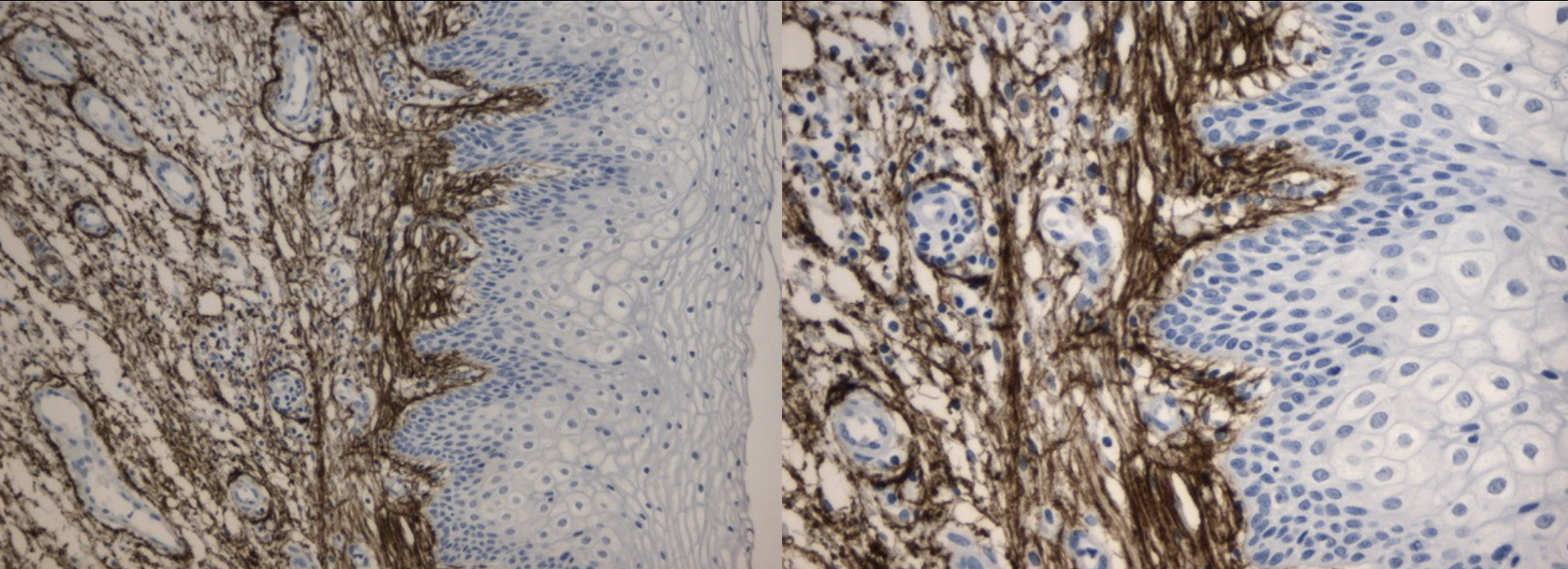Back
Introduction: The vestibule is an external genital structure lying 90° to the vaginal canal opening. The vestibule consists of non-keratinized squamous epithelium with numerous rete pegs, underlying lamina propria with nerves, blood vessels, glands, and extracellular matrix (ECM) proteins. During thrusting movements associated with penetrative sexual activity, the vestibule undergoes significant stretching during invagination/evagination. The vestibule also undergoes extreme stretching during childbirth. Elastin is an ECM protein in microfibrils that endows skin structures with ability to stretch, recoil, and have elasticity. Elastin has previously been shown to influence mechanical properties of tendons; degraded or abnormal elastin structures caused by aging or disease may contribute to pain and increased risk of injury. There are limited data on elastin in the vestibule in reproductive age patients and its role in vestibular elasticity/integrity.
Methods: 7 reproductive age patients with entrance dyspareunia from neuroproliferative vestibulodynia, with normal values of testosterone, estradiol, and progesterone, underwent complete vestibulectomy. Tissue blocks were created from the specimen, and 5 ?m sections studied with IHC primary antibody. Finally, sections were counterstained with Gill-modified hematoxylin.
Results: In all vestibular specimen, there was very high density of elastin underneath the epithelium in rete pegs and throughout the entire lamina propria. There is a density gradient with the highest density immediately deep to the basement membrane of the epithelium. Elastin fibers were arranged in all orientations: coronal (frontal), sagittal (longitudinal), and transverse (axial) planes.
Conclusions: The high density of elastin fibers in rete pegs and through the lamina propria in a multi-planar orientation is suggestive of extreme stretching capability in eugonadal vestibular tissues. The highest density of elastin staining was seen immediately below the basement membrane of the epithelium, which may provide tissue integrity and shear resilience to the epithelial layer. More research is needed on elastic fiber production, organization, and integration with other cutaneous extracellular matrix proteins, and how this may change during androgen insufficiency states such as menopause or with use of combined hormonal contraceptives. SOURCE OF
Funding: None

Moderated Poster Session
Session: MP27: Sexual Function/Dysfunction: Basic Research & Pathophysiology
MP27-14: Elastin Staining of the Vestibule
Saturday, April 29, 2023
7:00 AM – 9:00 AM CST
Location: S404C

Alyssa Yee, MD (she/her/hers)
Urologist and Sexual Medicine Physician
San Diego Sexual Medicine/Scripps Clinic
Poster Presenter(s)
Introduction: The vestibule is an external genital structure lying 90° to the vaginal canal opening. The vestibule consists of non-keratinized squamous epithelium with numerous rete pegs, underlying lamina propria with nerves, blood vessels, glands, and extracellular matrix (ECM) proteins. During thrusting movements associated with penetrative sexual activity, the vestibule undergoes significant stretching during invagination/evagination. The vestibule also undergoes extreme stretching during childbirth. Elastin is an ECM protein in microfibrils that endows skin structures with ability to stretch, recoil, and have elasticity. Elastin has previously been shown to influence mechanical properties of tendons; degraded or abnormal elastin structures caused by aging or disease may contribute to pain and increased risk of injury. There are limited data on elastin in the vestibule in reproductive age patients and its role in vestibular elasticity/integrity.
Methods: 7 reproductive age patients with entrance dyspareunia from neuroproliferative vestibulodynia, with normal values of testosterone, estradiol, and progesterone, underwent complete vestibulectomy. Tissue blocks were created from the specimen, and 5 ?m sections studied with IHC primary antibody. Finally, sections were counterstained with Gill-modified hematoxylin.
Results: In all vestibular specimen, there was very high density of elastin underneath the epithelium in rete pegs and throughout the entire lamina propria. There is a density gradient with the highest density immediately deep to the basement membrane of the epithelium. Elastin fibers were arranged in all orientations: coronal (frontal), sagittal (longitudinal), and transverse (axial) planes.
Conclusions: The high density of elastin fibers in rete pegs and through the lamina propria in a multi-planar orientation is suggestive of extreme stretching capability in eugonadal vestibular tissues. The highest density of elastin staining was seen immediately below the basement membrane of the epithelium, which may provide tissue integrity and shear resilience to the epithelial layer. More research is needed on elastic fiber production, organization, and integration with other cutaneous extracellular matrix proteins, and how this may change during androgen insufficiency states such as menopause or with use of combined hormonal contraceptives. SOURCE OF
Funding: None

